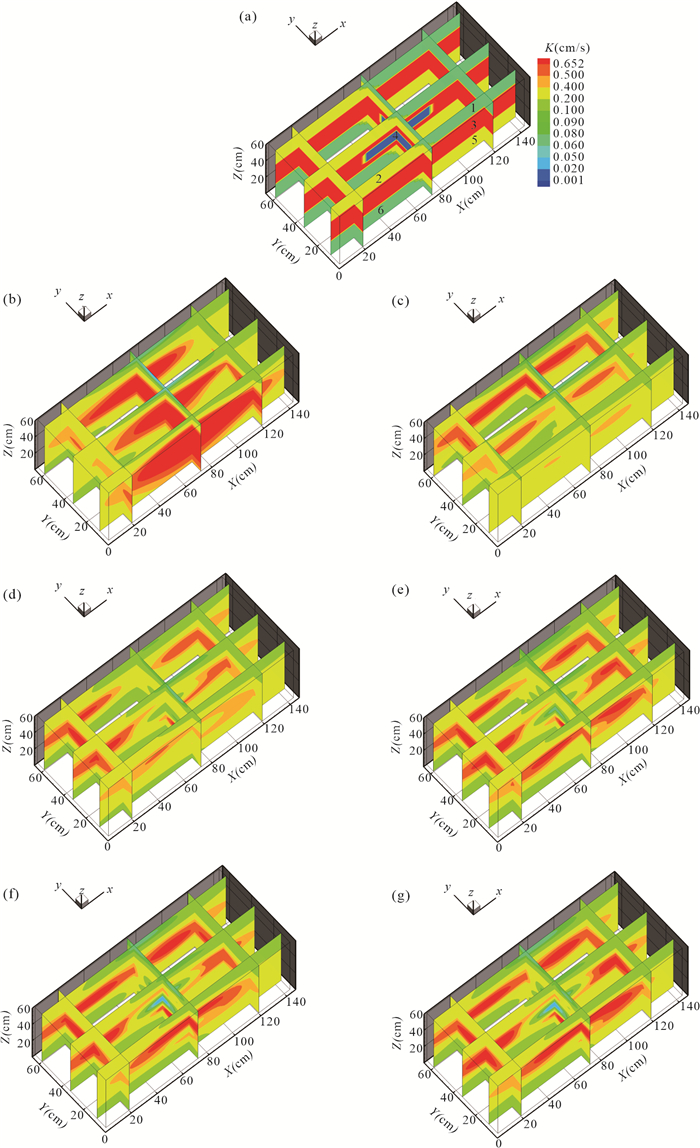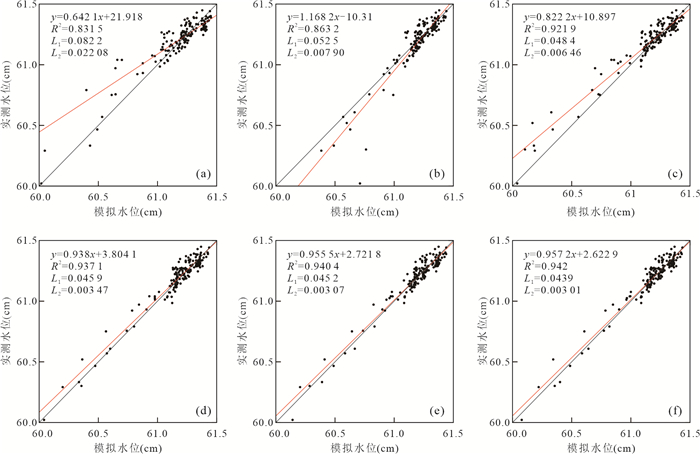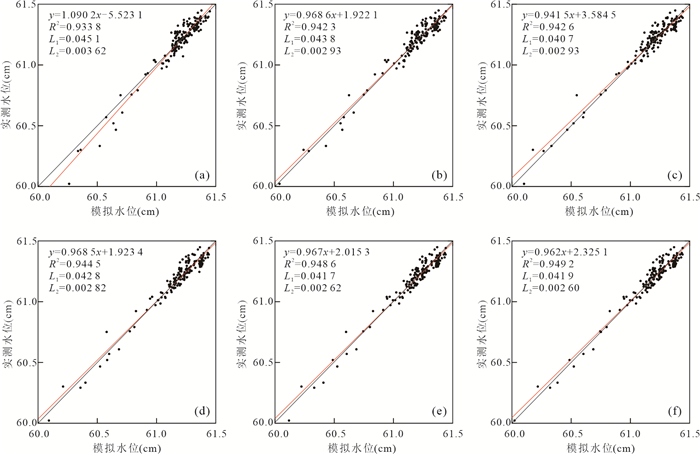Effect of Number of Pumping Tests and Prior Information on Hydraulic Conductivity Estimation of Three-Dimensional Heterogeneous Aquifer
-
摘要: 水力层析抽水实验可以高精度刻画非均质含水层渗透系数分布,但野外成本高,需要对抽水试验进行优化.通过构建三维非均质含水层砂箱,开展水力层析抽水实验,探讨不同抽水组数和先验信息对刻画渗透系数的影响.分别利用不同抽水组数和融入42个井段岩心渗透系数作为先验信息,对渗透系数场进行估算,并用以预测独立抽水实验过程,对比估算结果优劣.随着抽水组数增加,估算结果逐渐提升,再增加到8组,估算结果没有明显提升;融入先验信息后,2组抽水实验估算精度可达到无先验信息8组抽水实验估算的精度.在水力层析野外实践中,融入钻孔岩心渗透系数等先验信息,可减少抽水组数,降低试验成本.Abstract: Hydraulic tomography (HT) can accurately characterize the hydraulic conductivity (K) of field heterogeneous aquifer, but the field test cost is relatively high and pumping test need to be optimized. In order to explore the effect of number of pumping tests and prior information on the K estimates, we constructed a laboratory three-dimensional sandbox with heterogeneous aquifer, and then carried out pumping tests in HT survey. The K fields are respectively estimated using HT with and without 42 K values of core samples as prior information. The estimated K fields from different cases are then used to predict non-dependent pumping tests and compare the accuracy of estimated K fields. With increasing number of pumping tests, the estimated K fields are gradually improved. When pumping tests increase to eight groups, the K estimates are not significantly improve with the increase of pumping tests. 42 K values of core samples as prior information can greatly improve the K estimates in HT survey. The K obtained from only two pumping tests with prior information has almost same accuracy as the K estimates from the case of eight pumping tests without prior information.
-
表 1 不同抽水组数反演方案
Table 1. Inverse cases of different pumping tests for hydraulic tomography
抽水组数 抽水井段编号 观测水位总个数 2 26,39 82 4 9,26,34,39 164 6 9,12,26,34,36,39 246 8 4、9、12、17、26、34、36、39 328 10 4、9、12、17、20、26、31、34、36、39 410 12 4、9、12、17、20、23、26、31、34、35、36、39 492 -
Berg, S. J., Illman, W. A., 2015. Comparison of Hydraulic Tomography with Traditional Methods at a Highly Heterogeneous Site. Groundwater, 53(1): 71-89. https://doi.org/10.1111/gwat.12159 Bruggeman, G. A., 1972. The Reciprocity Principle in Flow Through Heterogeneous Porous Media. Developments in Soil Science, 2(2): 135-149. https://doi.org/10.1016/S0166-2481(08)70535-X Chen, C., Wen, Z., Liang, X., et al., 2017. Estimation of Hydrogeological Parameters for Representative Aquifers in Jianghan Plain. Earth Science, 42(5): 727-733 (in Chinese with English abstract). http://www.researchgate.net/publication/318835563_Estimation_of_Hydrogeological_Parameters_for_Representative_Aquifers_in_Jianghan_Plain Chen, C. X., Lin, M., Cheng, J. M., 2011. Groundwater Dynamics. China University of Geosciences Press, Wuhan (in Chinese with English abstract). Chen, X. L., Wen, Z., Hu, J. S., et al., 2016. Application of Numerical Simulation and Analytical Methods to Estimate Hydraulic Parameters of Foundation Pit in Hydropower Stations. Earth Science, 41(4): 701-710 (in Chinese with English abstract). Falade, G. K., 1981. Analysis of the Reciprocity Concept in a Porous Medium. Water Resources Research, 17(4): 918-920. https://doi.org/10.1029/WR017i004p00918 Gottlieb, J., Dietrich, P., 1995. Identification of the Permeability Distribution in Soil by Hydraulic Homography. Inverse Problems, 11(2): 353-360. https://doi.org/10.1088/0266-5611/11/2/005 Hao, Y. H., Yeh, T.C., Han, B. P., et al., 2008, Imaging Fracture Connectivity Using Hydraulic Tomography. Hydrogeology and Engineering Geology, 35(6): 6-11 (in Chinese with English abstract). http://en.cnki.com.cn/article_en/cjfdtotal-swdg200806007.htm Illman, W. A., Craig, A. J., Liu X., 2008. Practical Issues in Imaging Hydraulic Conductivity Through Hydraulic Tomography. Groundwater, 46(1): 120-132. https://doi.org/10.1111/j.1745-6584.2007.00374.x Illman, W. A., Liu, X. Y., Takeuchi, S., et al., 2009. Hydraulic Tomography in Fractured Granite: Mizunami Underground Research Site, Japan. Water Resources Research, 45(1): W01406. https://doi.org/10.1029/2007WR006715 Jiang, L. Q., Sun, R. L., Wang, W. M., et al., 2017. Comparison of Hydraulic Tomography and Kriging for Estimating Hydraulic Conductivity of a Heterogeneous Aquifer. Earth Science, 42(2): 307-314 (in Chinese with English abstract). http://en.cnki.com.cn/Article_en/CJFDTOTAL-DQKX201702012.htm Jiang, L. Q., Sun, R. L., Liang, X., 2020. Predicting Groundwater Flow and Transport in the Heterogeneous Aquifer Sandbox Using Different Parameter Estimation Methods. Earth Science, 46(11): 4150-4160 (in Chinese with English abstract). Liu, S. Y., Yeh, T.C., Gardiner, R., 2002. Effectiveness of Hydraulic Tomography: Sandbox Experiment. Water Resources Research, 38(4): 1034. https://doi.org/10.1029/2001WR000338 Renshaw, C. E., 1996. Estimation of Fracture Zone Geometry from Steady-State Hydraulic Head Data Using Iterative Sequential Cokriging. Geophysical Research Letters, 23(19): 2685-2688, https://doi.org/10.1029/96GL02415 Tsang, C. F., 2000. Simulation of Groundwater Flow and Solute Transport in Heterogeneous Media-Problems and Challenges. Earth Science, 25(5): 443-450 (in Chinese with English abstract). http://en.cnki.com.cn/Article_en/CJFDTOTAL-DQKX200005000.htm Wang, J. S., 2013. The Effect of Model Uncertainty on the Characterization of Hydraulic Parameters Using Hydraulic Tomography(Dissertation), China University of Geosciences, Wuhan (in Chinese with English abstract). Wang, W. M., Sun, R. L., 2015. Optimal Design of Sampling Time Using Hydraulic Tomography to Characterize the Heterogeneous Aquifer Hydraulic Conductivity and Storage Coefficient, Geological Science and Technology Information, 34(3): 165-170 (in Chinese with English abstract). Wang, W. M., 2013. The Optimal Design of Hydraulic Tomography Pump Test to Characterize the Heterogeneous Aquifer(Dissertation). China University of Geosciences, Wuhan(in Chinese with English abstract). Wen, J. C., Chen, J. L., Yeh, T.C., et al., 2019. Redundant and Nonredundant Information for Model Calibration or Hydraulic Tomography. Groundwater, 58(1): 79-92. https://doi.org/10.1111/gwat.12879 Wu, C. M., Yeh, T. C., Zhu, J., et al., 2005. Traditional Analysis of Aquifer Tests: Comparing Apples to Oranges?. Water Resources Research, 41(9): 1-15. https://doi.org/10.1029/2004WR003717 Xiang, J. W., Yeh, T.C., Lee, C.H., et al., 2009. A Simultaneous Successive Linear Estimator and a Guide for Hydraulic Tomography Analysis. Water Resources Research, 45(2): W02432. https://doi.org/10.1029/2008WR007180 Yeh, T.C., Jin, M., Samuel, H. A., 1996. Iterative Stochastic Inverse Method: Conditional Effective Transmissivity and Hydraulic Head Fields. Water Resources Research, 32(1): 85-92. https://doi.org/10.1029/95WR02869 Yeh, T.C., Liu, S. Y., 2000. Hydraulic tomography: Development of a New Aquifer Test Method. Water Resources Research, 36(8): 2095-2105. https://doi.org/10.1029/2000WR900114 Zha, Y. Y., Yeh, T.C., Mao, D. Q., et al., 2014. Usefulness of Flux Measurements during Hydraulic Tomographic Survey for Mapping Hydraulic Conductivity Distribution in a Fractured Medium. Advances in water Resources, 71(9): 162-176. https://doi.org/10.1016/j.advwatres.2014.06.008 Zha, Y. Y., Yeh, T, C., Illman, W. A., et al., 2016. An Application of Hydraulic Tomography to a Large-Scale Fractured Granite Site, Mizunami, Japan. Groundwater, 54(6): 793-804. https://doi.org/10.1111/gwat.12421 Zha, Y. Y., Yeh, T.C., Illman, W. A., et al., 2017. Incorporating Geologic Information into Hydraulic Tomography: A General Framework Based on Geostatistical Approach. Water Resources Research, 53(4): 2850-2876. https://doi.org/10.1002/2016WR019185 Zhao, R. J., Mao, D. Q., Liu, Z. B., et al., 2020. Analysis of Sequential Water Releasing Tests of Confined Aquifers in a Coal Mine Based on Hydraulic Tomography. Hydrogeology and Engineering Geology. 48(1): 1-9 (in Chinese with English abstract). http://www.sciencedirect.com/science/article/pii/S0022169420308106 Zhao, Z., Illman, W. A., Yeh, T.C., et al., 2015. Validation of Hydraulic Tomography in an Unconfined Aquifer: A Controlled Sandbox Study. Water Resources Research, 51(6): 4137-4155. https://doi.org/10.1002/2015WR016910 Zhao, Z., Illman, W. A., Berg, S. J., 2016. On the Importance of Geological Data for Hydraulic Tomography Analysis: Laboratory Sandbox Study. Journal of Hydrology, 542: 156-171. https://doi.org/10.1016/j.jhydrol.2016.08.061 Zhu, J., Yeh, T.C., 2005. Characterization of Aquifer Heterogeneity Using Transient Hydraulic Tomography. Water Resources Research, 41: W07028. https://doi.org/10.1029/2004WR003790 陈晨, 文章, 梁杏, 等, 2017. 江汉平原典型含水层水文地质参数反演. 地球科学, 42(5): 727-733. doi: 10.3799/dqkx.2017.060 陈崇希, 林敏, 成建梅, 2011. 地下水动力学. 武汉: 中国地质大学出版社. 陈晓恋, 文章, 胡金山, 等, 2016. 解析法与数值法在水电站防渗墙效果评价中的运用. 地球科学, 41(4): 701-710. doi: 10.3799/dqkx.2016.059 郝永红, 叶天齐, 韩宝平, 等, 2008. 运用水力层析法对含水层裂隙带成像. 水文地质工程地质, 35(6): 6-11. doi: 10.3969/j.issn.1000-3665.2008.06.003 蒋立群, 孙蓉琳, 王文梅, 等, 2017. 水力层析法与克立金法估算非均质含水层渗透系数场比较. 地球科学, 42(2): 307-314. doi: 10.3799/dqkx.2017.023 蒋立群, 孙蓉琳, 梁杏, 2020. 含水层非均质性不同刻画方法对地下水流和溶质运移预测的影响. 地球科学, 46(11): 4150-4160. doi: 10.3799/dqkx.2020.268 Tsang, C. F., 2000. 非均质介质中地下水流动与溶质运移模拟——问题与挑战. 地球科学, 25(5): 443-450. doi: 10.3321/j.issn:1000-2383.2000.05.001 王江思, 2013. 模型不确定性对水力层析法刻画含水层非均质性的影响研究(硕士学位论文). 武汉: 中国地质大学. 王文梅, 2013. 基于水力层析刻画含水层非均质性的抽水试验优化设计(硕士学位论文). 武汉: 中国地质大学. 王文梅, 孙蓉琳, 2015. 水力层析法刻画非均质含水层K与S采样时间优化设计. 地质科技情报, 34(3): 165-170. https://www.cnki.com.cn/Article/CJFDTOTAL-DZKQ201503023.htm 赵瑞珏, 毛德强, 刘再斌, 等, 2021. 基于水力层析法的某煤矿承压含水层叠加放水试验分析. 水文地质工程地质, 48(1): 1-9. https://www.cnki.com.cn/Article/CJFDTOTAL-SWDG202101001.htm -










 下载:
下载:






